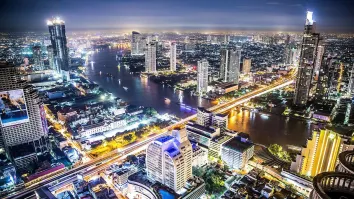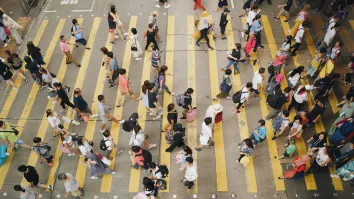A tour of the Chinese property sector
By Peter ZabierekIn a rapidly evolving place like China, it is important that any investment strategy reflects the conditions on the ground; frequent visits to check on the progress being made on infrastructure and industrial development in various regions is a crucial component of Urdang’s approach to investing in global property securities.
The most recent Chinese property tour started off in the Bohai Rim, the coastal region surrounding Beijing and Tianjin in northeastern China, which is racing at full speed toward greater economic modernisation and connectivity. The region’s real estate market has benefited from the emergence of new consumerism, embodied by the rapid rise in Chinese domestic demand, as has Shanghai, the tour’s final destination.
Over the past few years, the quantity and quality of property development in the Bohai Rim region of China has grown considerably. Expansion continues rapidly in response to strong residential, retail and commercial demand. At the same time, tremendous progress has been made in terms of the quality of construction, which now approaches, or in some cases exceeds, international standards. In fact, if one were to look at properties built by the same company five years apart, one would not recognise that these assets were constructed by the same developer.
Of course, while some companies still build purely lower-end utilitarian space, the majority of local developers have dramatically improved the quality of their construction.
Our tour of the coastal Bohai Rim region began in Shenyang, which was traditionally a major centre of heavy industry, particularly in the automotive sector. We saw a suburban, 4 million m² mall nearing the end of development, the value of this type of retail asset comparing well with other assets downtown which are more highly valued.
Although there is a fair amount of existing retail space in Shenyang, this property has an attraction that other malls lack; multi-mode accessibility. The asset not only has two subway lines stopping underneath it, but a major regional bus interchange is also located on the property. In addition, multiple surface roads allow for easy access by the increasing number of Chinese car owners. We believe the success of similar assets illustrates the healthy demand for this type of linked retail site. We also visited the historic retail area around Zhongjie Lu in the city’s Shenhe district, which has benefited from Chinese consumers’ growing appetite for global brands.
We walked the famous pedestrian shopping mall and visited a retail space that hosts nearly 300 tenants on five levels.
Beijing: Industrial
Known as the political and cultural centre of China, the capital city of Beijing has always been a major hub of every means of transportation. Our first stop was connected to this vast transportation system; a logistics facility on the southern end of Beijing’s airport. The key selling point of this asset is its ‘bonded’ warehouse. As Chinese export/import manufacturers continuously move up the economic value chain, adequate and protected storage to manage high-value inventory becomes critical for controlling costs.
Bonded warehouses offer this, as well as custom exemptions and a secured distribution site. Because of these factors, this type of storage facility typically charges a premium. In fact, operators can charge double the rental rates per m² compared to a traditional warehouse. There is always concern about oversupply in the industrial warehouse market, but a bonded site can become more attractive, in our opinion, if it is located near an airport or other major transportation system, and is facing limited competition.
Office
Our meetings with local brokers and landlords added to our conviction that the Beijing office market continues to strengthen. In the first quarter of 2011, the average rental rose 9.5% quarter- n-quarter to reach 188 renminbi per m². Meanwhile, total net absorption reached 309,521m² over the quarter, resulting in a decline in the overall availability ratio from 13.5% in the previous quarter to 9.2%. Investment trends are promising for the prime areas of the city, with yields on assets dropping below 5%.1
Residential
Finally, we visited a high-quality residential property which is well suited to Beijing’s burgeoning middle class. Located in the city centre, the development has 480 mostly two- to three-bedroom units ranging between 275 m² and 430m² in size. Of the 240 units that were released for sale at the end of March, 200 were sold by late April. Since supply in this desired development is limited, prices are expected to remain at current levels. While demand for this high-end project is strong, we understand that the Chinese government’s current restrictive measures aimed at controlling asset prices across the property sector have affected transaction levels in other parts of the city.
Government policy remains one of the key risks to the residential market, not only in Beijing, but across China. Tianjin: Multi-use. We continued our tour of the region with the high-speed train that was recently completed between Beijing and Tianjin. These bullet trains, which are connecting some of the country’s largest municipalities, are dramatically cutting commuting times between major centres of commerce.
The fifth largest city in China, Tianjin’s major resources include petroleum, salt and geothermal energy. The primary focus of our stop here was to visit a large multi-use development outside of Tianjin’s centre which is representative of an environmental sustainability project. Its developers have made extensive use of the newest energysaving techniques in the construction process.
Wind generation, solar arrays and better insulation, along with targets for water recycling and seawater desalination, are just some of the techniques underpinning this urban development. The entire site is led by a master developer who works in partnership with other builders to develop individual parcels of land. As each phase is developed, knowledge gained in its creation will be applied to future phases. Because of the eco-friendly technologies incorporated into the project, construction cost per m² is higher than average.
The project is being built on non-agricultural land, occupying old salt-pans outside the city, and although developers are currently unable to pass the 1500 renminbi per m² construction premium on to buyers, this additional cost is expected to be absorbed in the sales of future stages. The first residential phase has begun selling at 10,000 to 13,000 renminbi per m², but at a slower rate than the rest of Tianjin’s housing market. We believe that this type of large-scale sustainability laboratory could provide interesting investment opportunities.
Shanghai: Office
Our tour then took us outside the Bohai Rim to Shanghai, one of the most important port cities in China.
Shanghai’s office segment is in recovery since rents, which had fallen over 40% from a previous peak, are now rising. Although a significant amount of office supply is expected to hit the Shanghai market soon, a large portion of this future supply is being developed by local and multinational financial institutions for their own use. And, if current indicators are correct, we believe that remaining vacancies are expected to be quickly absorbed. We came away favourably impressed with the long-term viability of Shanghai’s office segment. The growing presence of global financial firms should lend credibility to this port town as a major financial centre, and is likely to draw other companies, such as law and accounting firms, into the area.
Retail Shanghai’s retail is a dizzying array, from simple suburban malls to high-end centres. If a mall is in a good location and has the proper mix of tenants for the area, it probably will find success in Shanghai. There is a drawback, however, to developing retail in this city. Because Shanghai is so built up, it lacks developable sites. An exception is a site of over 250,000m², which is still in development by one of the largest mall builders in Asia.
Suzhou: Industrial
About an hour and a half from Shanghai into the Yangzte River Delta is Suzhou, another large regional industrial centre. While in Suzhou, we toured an industrial park. When the industrial park was first developed, only single- torey buildings were allowed. However, new government rules now permit the construction of two-storey structures in the area. Therefore, use of land via vertical expansion brings with it the potential to double the rental income accrued, a boon to the company’s future profit estimates. Another positive feature of this type of site is its location. Typically, the economic value of industrial land is low. But because this land was acquired many years ago, it is now surrounded by residential areas, which allows for easy access and excellent infrastructure, as well as providing a justification for a premium price.
Residential
Within the city limits of Suzhou, there are two large lakes connected by two small waterways, which have become a recreational hub for city dwellers. The land surrounding these waterways has been sold to residential builders who have developed primarily single- amily homes. With a picturesque location and direct water access, these homes are expected to easily sell for 30,000 to 35,000 renminbi per m². We saw no impediment to developers receiving full price for these homes and expect demand to exceed supply. The final stop in our tour was a high-end villa project in the historical section of Suzhou. Although not large, the asset was of exceptional quality, with attractive landscaping and a superb location within the city’s fortified walls. The property management team has indicated that premium pricing of about 20,000 renminbi per m² is typical. In fact, the demand is so strong that one unit recently sold for 40 million renminbi (US$6.1 million). Again, we saw no obstacles in selling the vacant units at full asking price given the location, quality and demand.
Onward and upward
Generally speaking, we believe real estate in China’s Bohai Rim and the Shanghai area is thriving. Office rents are beginning to rebound from lows in 2010. Retail, especially in cities like Tianjin and Shenyang, has seen positive material growth. Industrial real estate in this area also appears to be performing strongly, as global logistics providers benefit from growing demand. And although the Chinese government has endeavoured to control housing prices, these policy measures have only cooled, not crashed, the region’s residential market. While a positive case may be made for residential real estate in the long term (given the government’s focus on this sector and the repositioning of the economy from exportdriven to consumption-oriented), we currently favour commercial development in China today.
Since commercial development influences residential and office demand in urban areas, we believe this may be a strong growth sector moving forward. In sum, the management of the real estate firms with whom we met not only appear to be operating smartly and successfully for the near term, but appear poised for strong cash flow and capital appreciation in the long term. We continue to be optimistic about the region’s major real estate segments, as well as the overall economic progress of these attractive and commercially important regions of China.



















 Advertise
Advertise








